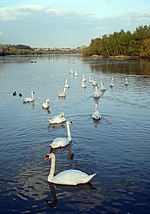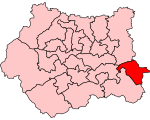Airedale, Castleford

Airedale is a suburb in the town of Castleford, West Yorkshire, England. It consists mainly of Local Authority Housing. It borders with Ferry Fryston. The ward of the City of Wakefield called Airedale and Ferry Fryston had a population of 14,811 at the 2011 Census. The River Aire runs in close proximity to Airedale and is thought to get its name from there. The area attracted much media attention in November 1984, when a local strikebreaker named Michael Fletcher was savagely beaten by a group of pickets during the UK miners' strike (1984-1985). A masked gang waving baseball bats invaded his house and beat him for five minutes, whilst his pregnant wife and two children hid upstairs. Two miners from Wakefield were later convicted of causing grievous bodily harm in the incident, whereas four others were acquitted of riot and assault.
Excerpt from the Wikipedia article Airedale, Castleford (License: CC BY-SA 3.0, Authors, Images).Airedale, Castleford
Lewin Grove, Wakefield Airedale
Geographical coordinates (GPS) Address Nearby Places Show on map
Geographical coordinates (GPS)
| Latitude | Longitude |
|---|---|
| N 53.726 ° | E -1.31 ° |
Address
Lewin Grove
Lewin Grove
WF10 3SF Wakefield, Airedale
England, United Kingdom
Open on Google Maps







